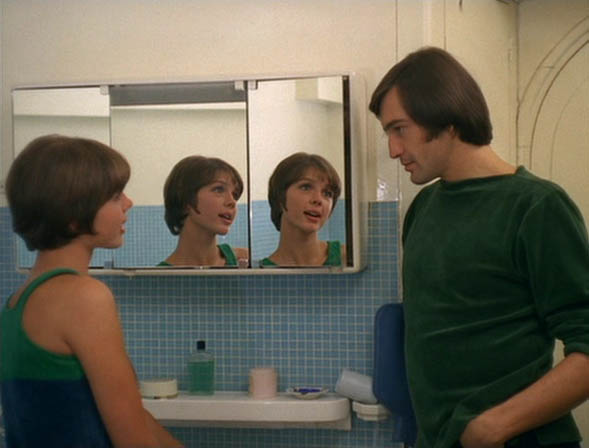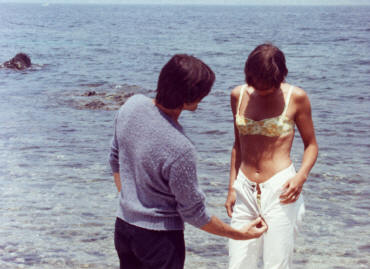In Which We Try To Do The Exact Right Thing
 Friday, September 19, 2008 at 1:08AM
Friday, September 19, 2008 at 1:08AM 
The Sexual Politics of Eric Rohmer
by Alex Carnevale
La collectionneuse
dir. Eric Rohmer
87 minutes
Eric Rohmer, the great French director, is still alive. Once that business of being alive has come to end, his reputation is going to build like a snowball rolling down a mountain.

La collectionneuse, the fourth film in his Six Moral Tales series, is about two men and one woman living in a villa in the South of France. It is Neil LaBute to the extreme, it is Your Friends and Neighbors in French, but nobody ever gets revenge.
The most seemingly misogynistic of Rohmer's films, La collectionneuse is about the way men personify women and make them into objects, and what happens afterwards.

The setting is the French Riviera, where Daniel and Adrien, a painter and an art dealer, chill out on eternal vacation from life.
And then she arrives:
[youtube=http://www.youtube.com/watch?v=75JH3UbW1H8]
The film's main subject is this figure, the gorgeous Haydee, who entertains the two monastic, upper-class intellectual misogynist Frenchies by hooking up with hot dudes and riding in their car. One of the monastics says of her at one point, "I didn't realize you were just looking for something." They term her The Collector, a devourer of men, even pawning her off on an artistic client at one point.

Haydee, as Adrien reflects in the voice-over narration time and time again, tries to get him to fall in love with her. Each step of the way, Adrien reiterates that she is doing the exact right thing if she wanted him to fall with her - even intercourse with the other housemate.

Nestor Almendros shot the film; before his death in 1992, he would also shoot Sophie's Choice, Kramer vs. Kramer, and Mike Nichols' Heartburn. The script (much of it improvised by the actors) is amazing, but the photography does it one better, proving why a film in black and white could never compare.

The dialogue is fast, modern and funny - you can see why Tarantino and Roger Avary admire Rohmer so much. He's also a gifted cinematographer who never tries to show off. As Philip Lopate writes in the accompanying Criterion essay:
By the time Eric Rohmer began shooting La collectionneuse, in 1967, he had already made the first two of his Moral Tales, the featurettes The Bakery Girl of Monceau (1962) and Suzanne’s Career (1963), and the thematic template of the series had been established: a man committed to one woman is tempted by a second but resists having sex with her, in the meantime turning himself inside out with analytical self-scrutiny.

He had actually planned to do La collectionneuse after My Night at Maud’s (1969), but the prospective star of that film, Jean-Louis Trintignant, was tied up with another shooting, and so the director decided to go ahead and direct this feature out of sequence, on a very low budget, with nonprofessionals and limited sets.

As James Monaco tells it in his valuable book The New Wave, “The only expenses that summer were for film stock and rent for the house in Saint-Tropez, which was the set and which also housed cast and crew. There was also a small budget line for the salary of the cook, who, the stories go, cooked nothing but minestrone during the entire shooting schedule.” All this may help explain why La collectionneuse has a somewhat transitional, in-between air: its three main characters, mooching for the summer off their absentee friend Rudolph’s beneficence, and Rohmer himself, waiting to start shooting the bigger-budget production that would come to be regarded as his masterpiece, are all marking time.

Adrien and Haydee, during their "friends" phase
The sense of contrast in an earthly paradise in which the loveliest landscapes serve as ironic background for the pettiest exchanges is heightened by Almendros’s extraordinary color photography, with its warm brown tones and deep, rich blues; its translation of the phenomenon of heat into light through the use of natural instead of artificial illumination and mirrors for softening; its pushing of film stocks to the limit in night scenes and shade shooting during the day to avoid the sun’s dramatic changes.

All these techniques, which would become hallmarks of Almendros’s, and Rohmer’s, later styles, were worked out for the first time in La collectionneuse, which the cinematographer, not surprisingly, came to regard as his favorite film. Almendros, who was quick to credit Rohmer’s hands-on approach (“Nothing could be done without his knowing about it and agreeing with it”), characterized the director’s overall photographic philosophy thusly: “His criterion is that if the image portrays the characters simply, and as close to real life as possible, they will be interesting.”

[youtube=http://www.youtube.com/v/D6VQi4o6TbM&rel=1]
Rohmer loves making characters do immoral things, and then seeing if you care about what happens afterwards. Most of what falls under the purview of immoral behavior comes in the battle of the sexes.
Neil LaBute's particular fascination is with depicting immoral behavior and then having its perpetrators get their just deserts, or almost get their just deserts.

It looks expensive.
A promiscuous woman is often the subject of ire. Haydee is excoriated, and yet she barely listens to her critics. She can't control who she is any more than the men who desire her can.
For the woman who left Jason Patric's character in Your Friends and Neighbors, he sends a letter from a doctor telling her she had AIDS. Here Haydee, through no fault of her own, drives every man absolutely crazy. She is marking time...but we are all marking time. For the men of In the Company of Men who decide to play a mean joke on a deaf girl, both end up with their lives destroyed. For Daniel and Adrien, the predators of La collectionneuse, there is a more profound and less obvious negative at the end of their sexism - a loneliness, and the realization that there is no control.

Alex Carnevale is the editor of This Recording.
[youtube=http://www.youtube.com/watch?v=YDZy0ZX_sAs]
"The '59 Sound" - The Gaslight Anthem (mp3)
"Let It Rock" - Kevin Rudolf ft. Lil Wayne (mp3)
"You Don't Know Me" - Ben Folds ft. Regina Spektor (mp3)
PREVIOUSLY ON THIS RECORDING
Sick ass dunks and Brigitte Bardot.
Time to break the fast.
Get money, new money.






























